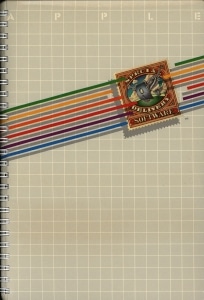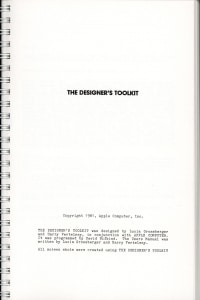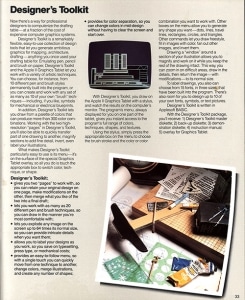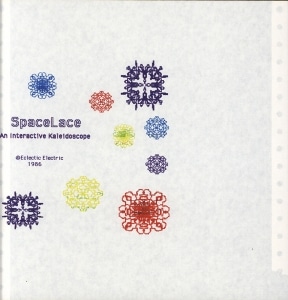 Computers are amazing machines. They can be serious tools for business or scientific research or they can be platforms for play. For many people, this has meant using computers to play games, but computers have also often served as engines for other forms of creative expression. Lucia Grossberger Morales is one example of someone who, in the early 1980s, not only employed the Apple II to create innovative art but designed a program, The Designer’sToolkit, to help others do the same.
Computers are amazing machines. They can be serious tools for business or scientific research or they can be platforms for play. For many people, this has meant using computers to play games, but computers have also often served as engines for other forms of creative expression. Lucia Grossberger Morales is one example of someone who, in the early 1980s, not only employed the Apple II to create innovative art but designed a program, The Designer’sToolkit, to help others do the same.
Grossberger was born in Bolivia in 1955 and shortly thereafter immigrated with her family to Southern California. At the University of Southern California, she studied anthropology as an undergrad and received a master’s degree in educational technology. She also developed an interest in art.
Those were heady years in California, where an exciting mix of innovative computer technology and counterculture utopianism opened up new creative possibilities. The era saw Silicon Valley come into being, including its most famous expression—Apple Computer. Founded by Steve Jobs and Steve Wozniak, Apple set out to bring the computer to the masses. The duo’s initial Apple computer garnered modest sales, but the company’s Apple II truly sparked a computer revolution. It did so in a wide variety of fields including education (Minnesota Educational Computer Consortium, publisher of The Oregon Trail, for example, played a key role in making Apple the favored provider of educational computers as The Strong discussed in an online exhibit). It also emerged as a favorite playground for those interested in creating and enjoying computer games.
 The Apple II certainly sparked a revelation for Lucia Grossberger, as she went by at the time. In 1979, she first encountered an Apple II computer. Suffering from allergies to some paints, she saw new possibilities with the computer. On her website, her profile recounts what happened: “That night she had a powerful dream. In the dream she had found a black box embedded in the sand next to the ocean. When she opened the box small dots of light burst out and danced in the night sky. At that moment, she knew the computer would be her artistic medium.”
The Apple II certainly sparked a revelation for Lucia Grossberger, as she went by at the time. In 1979, she first encountered an Apple II computer. Suffering from allergies to some paints, she saw new possibilities with the computer. On her website, her profile recounts what happened: “That night she had a powerful dream. In the dream she had found a black box embedded in the sand next to the ocean. When she opened the box small dots of light burst out and danced in the night sky. At that moment, she knew the computer would be her artistic medium.”
Computer art was not completely new in 1979. Four years earlier, Creative Computing had done a cover story on the subject. People had also begun producing commercial software to help others create their own striking images. Mark Pelczarski, for example, founded Penguin Software and created products such as Magic Paintbrush and The Complete Graphics System (Mark donated his papers to The Strong, something I wrote about back in 2015).
 Grossberger brought an artist’s perspective to the task, but she also believed that this was a powerful tool that needed to be shared with others. So through her company Eclectic Electric, she set about creating The Designer’sToolkit in partnership with Harry Vertelney and David Rifkind. Apple liked the program so much they chose to collaborate in marketing it.
Grossberger brought an artist’s perspective to the task, but she also believed that this was a powerful tool that needed to be shared with others. So through her company Eclectic Electric, she set about creating The Designer’sToolkit in partnership with Harry Vertelney and David Rifkind. Apple liked the program so much they chose to collaborate in marketing it.
The program let people draw directly on an Apple graphics tablet with a stylus. As the manual noted, “With a display of 53,760 pixels, (per picture) you can imagine that programming each pixel using machine language or Basic could be very time consuming.” Users then selected different effects for the artwork (such as the size of the brush or the color). It was a tremendously powerful tool for artistic creation, as well as many other applications in graphic design.
One of the most interesting venues for the product was the Us Festival, held in San Bernardino, California from September 3–5, 1982. The brainchild of Steve Wozniak, the co-founder of Apple, the festival featured a mix of musical acts (including Talking Heads, B-52s, and The Police) with the latest in computer technology. Companies like Atari and Mattel showcased their video game platforms, but one tent celebrated computer art and highlighted the work Grossberger had done in collaboration with Verteleney. As Grossberger said in an article about the event in the November 1982 issue of Microcomputing magazine, “We wanted to see what we could do with personal computers, I believed that you could have art on a floppy disk.”
Grossberger’s work also appeared in more traditional art venues—galleries and museums—in San Jose. In 1985, the San Jose Metro noted regarding a piece of hers on David Bowie, the “[t]ransitions from literal to abstract imagery are excellent, and the composition sustains interest throughout.” Another piece in that same show, “Space Lace,” eventually appeared as a commercial product (created in partnership with Bob Bishop) in the late 1980s and gave users the ability to transform computers into interactive kaleidoscopes.
The addition of Lucia Grossberger Morales’s papers to the archives at The Strong is an important boon for researchers. The documentation and news articles complement holdings from other key innovators of computer graphics of the period such as Mark Pelczarski (Penguin Software Collection) and Jordan Mechner. They also help chart the many new ways people were using the Apple II, something that the collections of the Minnesota Education Computer Corporation document as well. Lastly, they contribute to The Strong’s broader initiative to document the contributions of women to the history of video games through our Women in Games initiative. That is why the museum featured some of Lucia Grossberger Morales’s work in an exhibit on the subject that opened in November 2018.
It’s a fitting return for her work which is once again being showcased in a museum more than three decades after she first created it.
By Jon-Paul Dyson, Director, International Center for the History of Electronic Games and Vice President for Exhibits
 Hours 10 a.m.–5 p.m. | Fri. & Sat. till 8 p.m.
Hours 10 a.m.–5 p.m. | Fri. & Sat. till 8 p.m.
